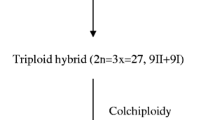Abstract
The genetic variability of five natural populations ofNajas marina L., i.e. one diploid of subsp.marina (Europe), two of subsp.intermedia (Europe) and both a diploid (C. Africa) and a tetraploid (Middle East) of subsp.armata, has been estimated by means of electrophoretic studies. These populations differ in their morphology and karyotype. Emphasis is placed on the characteristics and status of a tetraploid cytotype from Merkaz Sappir (Israel). Almost all the variation observed is expressed in seed alcohol dehydrogenase (ADH). The differences are in a unique allele of theAdh-2 locus and in the formation of novel heteromeric isozymes.Adh genes in seeds can be used as a marker for the autotetraploid character. The other enzyme systems tested failed in this respect. The genetic variability based on 23 loci is rather low. Nevertheless, the autotetraploid population has a higher or equal ratio of polymorphic loci than the related diploids. Cluster analysis illustrated not only thatNajas marina subsp.marina has diverged much from subsp.intermedia and subsp.armata, but also showed the difference between the latter two taxa, as well as the intermediate position of the autotetraploid population.
Similar content being viewed by others
References
Agami, M., Waisel, Y., 1986: The role of mallard ducks (Anas platyrhynchos) in the distribution and germination of seeds of the submerged hydrophyteNajas marina L. — Oecologia68: 473–475.
—,Eshel, A., Waisel, Y., 1984:Najas marina in Israel: is it a halophyte or a glycophyte? — Physiol. Plant.61: 634–636.
—,Beer, S., Waisel, Y., 1986: The morphology and physiology of turions inNajas marina L. in Israel. — Aquat. Bot.26: 371–376.
Crawford, D. J., 1985: Electrophoretic data and plant speciation. — Syst. Bot.10: 405–416.
—,Smith, E. B., 1984: Allozyme divergence and intraspecific variation inCoreopsis grandiflora (Compositae). — Syst. Bot.9: 219–225.
Epes, D. A., Soltis, D. E., 1984: An electrophoretic investigation ofGalax urceolata (Diapensiaceae). — Amer. J. Bot.71: 165 (Abstract).
Gottlieb, L. D., 1981: Electrophoretic evidence and plant populations. — Progress Phytochem.7: 1–46.
Henriksen, U. B., Jelnes, J. E., 1980: Experimental taxonomy ofBiomphalaria (Gastropoda: Planorbidae). 1. Methods for experimental taxonomic studies onBiomphalaria carried out by horizontal starch gel electrophoresis and staining of 12 enzymes. — J. Chromatography188: 169–176.
Jackson, R. C., 1985: Genomic differentiation and its effect on gene flow. — Syst. Bot.10: 391–404.
Nei, M., 1978: Estimation of average heterozygosity and genetic distance from a small number of individuals. — Genetics89: 583–590.
Rogers, J. S., 1972: Measures of genetic similarity and genetic distance. — Studies in Genetics, Univ. Texas Publ.7213: 145–153.
Roose, M. L., Gottlieb, L. D., 1976: Genetic and biochemical consequences of polyploidy inTragopogon. — Evolution30: 818–830.
Soltis, D. E., Bohm, B. A., 1984: Autopolyploidy inTolmiea menziesii (Saxifragaceae). — Amer. J. Bot.71: 189 (Abstract).
Swofford, D. L., Selander, R. B., 1981: BIOSYS-1: a FORTRAN program for the comprehensive analysis of electrophoretic data in population genetics and systematics. — J. Heredity72: 281–283.
Triest, L., 1986: Revisie van het geslachtNajas L. (Najadaceae) in de oude wereld: kenmerken, taxonomie en isozymenpolymorfisme. — PhD. thesis, Fac. Wetenschappen, Vrije Universiteit Brussel.
—, 1987: A revision of the genusNajas L. (Najadaceae) in Africa and surrounding islands. — Acad. Roy. Sci. d'Outre-Mer, Cl. Sci. nat.-méd., Mém. in-8°, Nouv. Sér.21 (4): 1–88+XVII pl. — Bruxelles, Acad. Roy. Sci. d'Outre-Mer.
- 1989: Electrophoretic polymorphism and divergence inNajas marina L. (Najadaceae): molecular markers for individuals, hybrids, cytodemes, lower taxa, ecodemes and conservation of genetic diversity. — Aquat. Bot. (in press).
—,Symoens, J. J., 1985: Isozyme patterns and taxonomic position of a Central African population ofNajas marina L. subsp.armata (Lindb. f.)Horn af Rantzien. — Bull. Jard. Bot. Nat. Belg.55: 261–269.
—,Van Geyt, J., Ranson, V., 1986: Isozyme polymorphism in several populations ofNajas marina L. — Aquat. Bot.24: 373–384.
Vallejos, C. E., 1983: Enzyme activity staining. — InTanksley, S. D., Orton, T. J., (Eds.): Isozymes in plant genetics and breeding A, pp. 469–516. — Amsterdam: Elsevier.
Van Geyt, J., Smed, E., 1984: Polymorphism of some marker enzymes of the sugarbeet (Beta vulgaris L.) investigated by polyacrylamide gel electrophoresis and starch gel electrophoresis. — Zeitschr. Pflanzenzücht.92: 295–308.
—, 1986: Mode of inheritance and some general characteristics of sugarbeet alcohol dehydrogenase. — Plant Sci.46: 143–149.
—, 1987: Characterisation of alcohol dehydrogenase inNajas marina L. — Aquat. Bot.28: 129–141.
Viinikka, Y., 1976:Najas marina L. (Najadaceae): Karyotypes, cultivation and morphological variation. — Ann. Bot. Fenn.13: 119–131.
—,Agami, M., Triest, L., 1987: A tetraploid cytotype ofNajas marina L. — Hereditas106: 289–291.
Author information
Authors and Affiliations
Rights and permissions
About this article
Cite this article
Triest, L., Viinikka, Y. & Agami, M. Isozymes as molecular markers for diploid and tetraploid individuals ofNajas marina (Najadaceae). Pl Syst Evol 166, 131–139 (1989). https://doi.org/10.1007/BF00937881
Received:
Revised:
Issue Date:
DOI: https://doi.org/10.1007/BF00937881




